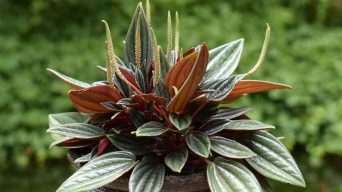ZZ plants (Zamioculcas zamiifolia) are very popular houseplants and for a good reason!
They are low-maintenance, easy to care for, and make a beautiful addition to any home.
However, like all plants, they can suffer problems if they are not cared for properly.
One common problem that ZZ plants experience is underwatering.
Here’s what you need to know about an underwatered ZZ plant, how to identify it, and what to do to fix the problem.
What Are the Risks of Underwatering a ZZ Plant?
While ZZ plants tolerate neglect, they will suffer if they are consistently underwatered.
Underwatering can lead to several problems, including:
Water is essential to a plant for several reasons.
It helps the plant to transport nutrients and minerals from the soil, and it also helps support the plant’s structure.
Most of the water a plant takes in is used to evaporate water from the leaves (a process called transpiration), which helps to cool the plant and keep it from wilting.
When a plant is underwatered, it can’t perform these essential functions properly.
In severe cases, this can lead to several problems, including:
- The plant stops growing
- The plant becomes more susceptible to pests and diseases
- The plant growth is stunted
- The roots start to rot
- The plant eventually dies
As you can see, ensuring your ZZ plant gets the water it needs to avoid these problems is essential.
How Does Underwatering a ZZ Plant Occur
There are a few different ways that underwatering can occur.
The most common causes are:
Inadequate Watering Schedule
One of the most common reasons for underwatering is simply not watering the plant enough.
ZZ plants are drought-tolerant, so they don’t need a lot of water to begin with.
However, they do need some water to survive.
If you’re not watering your ZZ plant regularly, likely the plant is not getting enough water.
ZZ plants need to be watered every one to two weeks, depending on the pot size and the plant’s size.
To water a ZZ plant, soak the soil until it is evenly moist and allow the excess water to drain away.
If you’re unsure how often to water your ZZ plant, check the soil before watering.
If the top inch of soil is dry, it’s time to water.
Incorrect Pot Size
Another common cause of underwatering is using a pot that is too small for the plant.
When a plant is in a too small pot, the roots can’t access all the water they need.
As a result, the plant dries out more quickly.
To avoid this problem, choose a pot that is slightly larger than the ZZ plant root ball.
Improper Drainage
Another possible cause of underwatering is improper drainage.
When the soil doesn’t drain well, the roots can’t access the water they need.
Choose a pot with drainage holes and use a well-draining potting mix to avoid this problem.
Your potting soil should be light and airy, with a mixture of sand, perlite, and peat moss.
You can also add a layer of gravel to the bottom of the pot to help with drainage.
Hot, Dry Conditions
Another possible cause of underwatering is hot, dry conditions.
If the air around your plant is very dry, it can cause it to lose water more quickly.
Also, if the temperature is too hot, the plant will transpire more water than usual, leading to dehydration.
To avoid this problem, ensure that your ZZ plant has some humidity.
You can do this by placing the pot on a tray of pebbles and water or by misting the ZZ plant leaves with water.
You can also use a humidifier to increase the humidity around your plant.
Poor Root System
Another possible cause of underwatering is a poor root system.
If the roots are damaged or unhealthy, they won’t be able to absorb water as well.
This can lead to dehydration and other problems.
Roots can become damaged or unhealthy for several reasons, including:
- Root rot
- Pests or diseases
- Excessive fertilizer
- Improper handling when transplanting
If you suspect your plant has a poor root system, replanting it in fresh soil is best.
This will give the plant a chance to establish a healthy root system.
Too Much Sunlight
Another possible cause of underwatering is too much sunlight.
If the plant is in direct sunlight for too long, it can lose water more quickly.
To avoid this problem, provide your ZZ plant with filtered light or indirect sunlight.
You can do this by placing the plant near a window with morning or afternoon sun.
ZZ plants thrive in bright indirect light.
Root-Bound Plant
Another possible cause of underwatering is a root-bound plant.
When a ZZ plant is root-bound, the roots have grown too big for the pot.
As a result, the roots start to circle the pot and become tangled.
This can cause problems with the plant’s ability to absorb water and nutrients.
If you suspect your plant is root-bound, replanting it in a larger pot is the best course of action.
Root Rot
Root rot is another possible cause of underwatering.
Root rot is a fungal disease that affects the roots of plants.
It can cause the roots to become mushy and break down.
This can lead to several problems, including decreased water and nutrient absorption.
If you suspect your ZZ plant has root rot, the best action is to trim away the affected roots and replant the plant in fresh soil.
Pest Infestation
A pest infestation is another possible cause of underwatering.
If your plant is infested with pests, it can damage the roots and prevent it from absorbing water.
ZZ plants’ common pests include mealybugs, aphids, and spider mites.
If you suspect your plant has a pest infestation, the best course of action is to isolate it and treat it with a natural insecticide.
How To Tell If Your ZZ Plant Is Underwatered
It’s essential to be able to tell if your ZZ plant is underwatering.
The plant can suffer irreversible damage if you don’t catch it early.
That’s why it’s essential to know the signs of underwatering.
Some common signs of underwatering include:
Signs of an Underwatered ZZ Plant
There are a few different signs that you can look for to tell if your ZZ plant is underwatering.
These signs include:
Drooping Leaves
One of the most common signs of underwatering is drooping leaves.
When a plant lacks water, the leaves start drooping and sagging.
This is because the plant is not getting enough support from the water in the soil.
Seeing your ZZ plant’s leaves drooping indicates that the plant needs more water.
Yellow Leaves
Yellow leaves often signal that a plant is not receiving adequate water.
When a plant experiences water deficiency, its leaves tend to take on a yellow or brown hue. This change in leaf color occurs because the plant isn’t receiving sufficient nutrients through the water in the soil.
If you notice that the leaves of your ZZ plant are turning yellow, it’s a clear indicator that the plant requires more water.
Wilted Appearance
A wilted appearance is another common sign of underwatering.
When a plant lacks water, it will look wilted and lifeless.
This is because the plant is not getting enough moisture from the soil.
If your ZZ plant looks wilted, check the soil to see if it’s dry.
If it is, the plant needs more water.
Curling Leaves
Curling leaves are another common sign of underwatering.
When a plant lacks water, the leaves start to curl up and turn brown.
This is because the plant is not getting enough moisture from the soil.
If you see your ZZ plant’s leaves curling, check the soil to see if it’s dry.
If it is, the plant needs more water.
Brown Spots on Leaves
Brown spots on leaves are another common sign of underwatering.
When a plant lacks water, the leaves will start to turn brown and dry out.
This is because the plant is not getting enough moisture from the soil.
It usually starts as brown leaf tips or edges but can eventually spread to cover the entire leaf.
If you see brown spots on your ZZ plant’s leaves, it indicates that it needs more water.
Dry or Cracked Soil
Another common sign of underwatering is dry or cracked soil.
When the soil is too dry, it can start to crack and pull away from the sides of the pot.
When the soil has been dry for too long, it can also start to form a crust on the surface.
If you see any of these signs, it indicates that your plant needs more water.
Slow Growth
Underwatering can also cause slow growth.
When a plant lacks water, it will have trouble absorbing nutrients from the soil.
As a result, the plant will grow more slowly than it would if adequately watered.
If your ZZ plant’s growth has slowed, check the soil to see if it’s dry.
If it is, the plant needs more water.
Leaf Drop
Leaf drop is another common sign of underwatering.
When a plant lacks water, the leaves will start to fall off.
This is because the plant cannot support the weight of the leaves.
Seeing your ZZ plant leaves falling off indicates that the plant needs more water.
Stems That Are Soft or Hollow
Underwatering can also cause the stems of your plant to become soft or hollow.
When a plant lacks water, the stems cannot support the leaves’ weight.
As a result, the stems will start to sag and even break.
If your ZZ plant’s stems become soft or hollow, it’s a good indication that it needs more water.
How To Save an Underwatered ZZ Plant
If you think your ZZ plant is underwatering, you can do a few things to save it.
Here are a few tips:
1. Water Deeply and Thoroughly
The first thing you need to do is water deeply and thoroughly.
Water the plant until the water starts to run out of the bottom of the pot.
This will ensure that the plant’s roots are getting enough moisture.
2. Let the Soil Dry Out Between Waterings
After you’ve watered your plant, let the soil dry out completely before watering again.
This will help the plant’s roots to develop properly.
Just ensure you don’t let the soil dry out for too long.
If the soil dries out too much, it can damage the plant’s roots.
3. Use a Pot with Drainage Holes
When watering your plant, use a pot with drainage holes.
This will allow the water to drain from the pot and prevent the plant from sitting in water.
If the plant is sitting in water, it can lead to root rot.
4. Use the Right Soil
When potting your plant, make sure to use a well-draining soil.
Soils that drain well will help to prevent the plant from becoming waterlogged.
To improve drainage, you can also add some perlite or sand to the soil.
5. Move Your Plant to a More Humid Location
If your plant is in a dry environment, it may struggle to get enough moisture.
Try moving your plant to a more humid location, such as a bathroom or kitchen.
You can also try misting your plant with water to increase the humidity around it.
6. Use a Humidity Tray
If you can’t move your plant to a more humid location, try using a humidity tray.
To do this, place the pot on a tray of pebbles and water.
The water will evaporate and increase the humidity around the plant.
7. Be Patient
It may take some time for your plant to recover from underwatering.
So, be patient and don’t give up on your plant.
With some time and care, your plant will soon return to its old self.
How To Prevent Underwatering a ZZ Plant
If you’re concerned about underwatering your ZZ plant, you can do a few things to help prevent it.
Here are a few tips to help you avoid underwatering your ZZ plant:
1. Check the Soil Before Watering
Before you water your plant, it’s essential to check the soil.
If the top inch or so of soil is dry, it’s time to water.
If the soil is still moist, you can wait a few days before watering again.
2. Water Your Plant Deeply
When you do water your plant, make sure to water it deeply.
ZZ plants like their roots to be wet, so water until it starts to run out of the pot’s drainage holes.
3. Use Room Temperature Water
Use room temperature water when watering your plant.
Cold water can shock the roots and lead to root rot.
4. Let the Soil Dry Out Between Waterings
It’s essential to let the soil dry out between waterings.
If you water your plant too often, you can overwater it and cause root rot.
5. Use a Moisture Meter
If you’re unsure when to water your plant, you can use a moisture meter.
Stick the moisture meter into the soil and see what the reading says.
If the meter reads “dry,” it’s time to water your plant.
6. Avoid Direct Sunlight
ZZ plants do best in indirect sunlight.
If you live in a hot climate, avoiding direct sunlight is essential, as it can make the plant lose moisture faster.
7. Group Plants Together
ZZ plants do best when they’re grouped with other plants.
Not only does this help them to retain moisture, but it also protects them from the sun.
8. Use a Well-Draining Soil
Make sure to use a well-draining soil when potting your ZZ plant.
Soil that doesn’t drain well can lead to root rot.
9. Cut Back on Fertilizer
Fertilizing your plant can lead to fertilization burn, damaging the roots.
It’s best to cut back on fertilizer and only use it every few months during the growing season.
10. Be Careful When Transplanting
When transplanting your ZZ plant, be careful not to damage the roots.
Transplant shock can lead to root rot, so handling your plant gently is essential.
11. Inspect Your Plant Regularly
Inspecting your plant regularly for signs of stress is a good idea.
If you see any yellowing or wilting leaves, that’s a sign that your plant is not getting enough water.
It’s essential to catch these signs early and take action to prevent further stress on your plant.
Final Thoughts
Underwatered ZZ plants are a common problem but easy to fix.
If you think your plant is underwatered, check the soil to see if it’s dry.
If it is, water your plant thoroughly and ensure the pot has drainage holes so the excess water can drain out.
Underwatered ZZ plants are more common in the winter when the plant is dormant and doesn’t need as much water.
Watering your plant regularly during the growing season and less often during the winter is essential.
Keep an eye on your plant, and if you see any signs of underwatered ZZ plants, take action immediately.
If you’re unsure whether your plant is underwatered or overwatered, consider buying a moisture meter to help you out.
With some care, your plant will be healthy and happy in no time.







